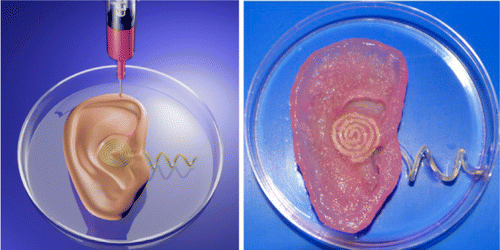The Disgusting, Amazing Printed Ear

What do you get when you combine 3D printing, sheep cartilage, lab rats, and a little bit of titanium? A human ear.
Researchers at Massachusetts General Hospital, led by bioengineer Thomas Cervantes, announced the successful creation of a lifelike, flexible ear from totally nonhuman sources in the Journal of the Royal Society Interface this summer.
The team used a 3D printer to create a titanium mesh scaffold for the ear, which was then seeded with sheep cartilage cells. The cells grew across the mesh over a period of about three months, creating an ear that can be tailored to mimic the recipient's natural aural appendages-a vast improvement over the current laborious process in which a plastic surgeon carves a rough ear out of cartilage harvested from the patient's own ribs.
To test the ear's performance when hooked up to a blood supply, researchers implanted it onto the backs of lab rats. They were pleased with the results.
"For something like the ear where it's very cosmetic in nature, having a proper shape is one of the most important requirements. We wouldn't want it to look like a shriveled nub," Cervantes, now based at Stanford, told LiveScience.
Editor's Note: As of February 29, 2024, commenting privileges on reason.com posts are limited to Reason Plus subscribers. Past commenters are grandfathered in for a temporary period. Subscribe here to preserve your ability to comment. Your Reason Plus subscription also gives you an ad-free version of reason.com, along with full access to the digital edition and archives of Reason magazine. We request that comments be civil and on-topic. We do not moderate or assume any responsibility for comments, which are owned by the readers who post them. Comments do not represent the views of reason.com or Reason Foundation. We reserve the right to delete any comment and ban commenters for any reason at any time. Comments may only be edited within 5 minutes of posting. Report abuses.
Please to post comments




Thank you very much
Thank you very much
when hooked up to a blood supply, researchers implanted it onto the backs of lab rats. They were pleased with the re